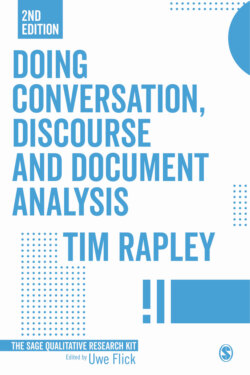Читать книгу Doing Conversation, Discourse and Document Analysis - Tim Rapley - Страница 17
На сайте Литреса книга снята с продажи.
Sources of ‘data’
ОглавлениеTo put it very simply, we could divide your possible sources of ‘data’ into two categories: data that you have to generate and data that already exists. By that I mean to contrast, say, a research interview you conduct on the topic of genetic disease with, say, a newspaper article on genetic disease. The newspaper article, on the face of it, exists independently of your action whereas the research interview exists only due to your action. So we could divide the potential sources of data into these two categories: researcher-generated and already existing data. However, this assumes that you are somehow more ‘active’ with the former category and reasonably ‘passive’ or ‘neutral’ in relation to the latter. In both cases your actions are utterly central in producing the materials as ‘data’. In both cases you have to actually discover it, physically collect it, make decisions about what materials you are going to gather and what materials you are going to ignore. Irrespective of the actual form of the materials – video recordings of television programmes, audio files of focus groups, newspaper articles, screen shots of web discussion groups or photocopies of academic journal articles – you have made certain choices. Importantly, you have decided to call this specific ensemble of materials, which you collected together, your ‘data’.
So where does that leave us? In reports of research, some things are named as ‘data’ and some activities are named as ‘data collection’; other things and activities do not hold the same status. In one project I worked on, the two ‘official’ sources of data were:
video recordings of doctor–patient consultations about a specific condition; and
audio files of research interviews with patients about the consultation.
However, the findings of the research are also the product of the engagement with the following materials:
Transcripts of the doctor–patient interactions and research interviews.
Handwritten and typed field notes of what happened prior to, during and after the consultations and interviews.
Field notes, audio files and minutes of the research team’s meetings and other related activities.
Official documents distributed by the research team (including patient information leaflets, consent forms, funding documents and research reports).
Academic research papers and books (covering such topics as social scientists writing about doctor–patient interactions; medical researchers and ethicists writing about a specific medical condition and doctor–patient interactions; and social scientific and scientific research methodology texts).
Leaflets, handouts and newspaper cuttings (covering a specific medical condition).
Websites (aimed specifically at social and medical researchers and the general public).
Assorted handwritten and typed notes to myself, memos and quotes.
For me, all these materials were ‘my data’. Or rather, as I prefer it, all these materials made up my archive. This archive, combined with conversations with the research team, friends, strangers, watching television, listening to the radio, reading novels, et cetera, and most importantly, bolts from the blue (often over a large cup of coffee), enable the production of specific research findings and papers.
I could easily have called this whole section ‘Generating data’. And I would have probably focused on roughly the same things. However, the scare quotes I have placed around the word ‘data’ may suggest I have a problem with the term. I am never quite sure when I am conducting my own research what actually is my ‘data’ and what is not my ‘data’. Is a quote I take from a recording of a doctor–patient consultation data? Whereas the quote I take from a social science article discussing doctor–patient consultations is not data? I use both to develop my argument, so for me both are data. Equally, are the topics covered in the interview data? Whereas the interview schedule itself and the reading and discussions that led to its development are somehow not data? All these areas of activity are central to producing my arguments.
Rather than just thinking about ‘generating data’, in any narrow sense, you need to think about generating or producing an archive – a diverse collection of materials that enable you to engage with and think about the specific research problem or questions. On a practical level, this means collecting and managing an array of different materials. Obviously, what materials make up your archive is directed by both your specific research question and your theoretical trajectory. In order to briefly review the possible sources of researchable materials, I am going to divide the following discussion into two areas: document-based sources and audio- and visual-based sources. I should note that this is a wholly arbitrary division. For example, when an audio file is transcribed it is, in one sense, translated into a document. However, this arbitrary or working division is just that, and is based on my need to offer you an accessible and manageable story.
